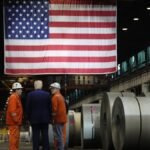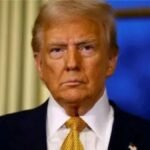The Alaska summit between Donald Trump and Vladimir Putin concluded without any ceasefire agreement in Ukraine, leaving allies in Europe and Kyiv anxious. The meeting lasted three and a half hours, but produced no concrete results.
Trump had hoped to score an international peace achievement, even considered a Nobel Peace Prize, but those ambitions vanished as the discussions faltered. The key word of the meeting, “ceasefire,” was notably absent from any agreement.
Ukraine, European nations, and supporters of democratic norms watched closely, worried that Trump might echo Putin’s demands. In the past, Trump has publicly endorsed Russian claims over captured Ukrainian territories, raising concern among allies.
Putin made no concessions during the meeting. After hours of talks, both leaders emerged with no joint statement or plan to present to the world. The summit highlighted the power imbalance between the two leaders.
Trump said he would call NATO leaders and President Volodymyr Zelensky to update them about the discussion. He added, “We’ve made some headway. So there’s no deal until there’s a deal. I will call up NATO in a little while.”
[inline_related_posts title=”RECOMMENDED” title_align=”left” style=”list” number=”1″ align=”none” ids=”” by=”categories” orderby=”rand” order=”DESC” hide_thumb=”no” thumb_right=”no” views=”no” date=”yes” grid_columns=”2″ post_type=”” tax=””]
Observers noted that Trump’s phrasing suggested uncertainty. Analysts said he seemed reluctant to publicly outline what was discussed after hosting an indicted war criminal in U.S. territory.
Putin arrived in Alaska to a red carpet welcome, accompanied by an Air Force flypast. Trump shook his hand twice and offered him a ride in the presidential armored vehicle, known as “the beast.”
During the summit, Putin appeared relaxed and confident, displaying expressive gestures that drew international attention. He remained composed and firm in his position, contrasting Trump’s increasingly tense demeanor.
Putin stated that Russia is “sincerely interested” in ending the war but insisted that all root causes of the conflict must be addressed. He emphasized Russia’s security concerns and the need to balance security in Europe and the world.
He also mentioned Ukraine’s security, saying, “Naturally, the security of Ukraine should be ensured as well. Naturally, we are prepared to work on that,” without specifying actionable steps toward a ceasefire.
Analysts highlighted that Putin continues to frame the Ukraine war as a consequence of the Soviet Union’s collapse. He seeks to reassert Russian influence across Eastern Europe, challenging current European and NATO arrangements.

European nations and Canada now provide the majority of civilian and military aid to Ukraine, surpassing the United States. Their contributions total approximately €250 billion, compared with the U.S. contribution of €114 billion.
Trump has reduced U.S. military aid to Kyiv and insisted that NATO members handle Ukraine’s defense. His position has caused concern among European leaders, who fear the United States may not fully support Ukraine in future negotiations.
Sir Keir Starmer and other European officials had previously warned Trump not to be “steamrolled” by Putin. The summit’s outcome suggests these warnings were necessary, given Trump’s handling of the discussions.
Putin hinted that Trump’s follow-up calls to Zelensky and NATO might be unwelcome. The Kremlin leader suggested that Ukraine and European capitals may not accept any proposals that resemble Russian preferences.
Trump concluded the summit with optimistic language, claiming that “we’re gonna stop really, five six seven thousand, thousands of people a week from being killed,” while indicating a likely return visit to Moscow with Putin.
The event has sparked criticism from diplomats and media, emphasizing that no progress was made toward peace in Ukraine. Many described the summit as a public humiliation for the U.S. president rather than a diplomatic victory.
Observers noted that the visual symbolism of hosting Putin, including handshakes and the red carpet welcome, elevated the Russian leader’s global standing. Analysts said it reinforced perceptions of Trump being outmaneuvered.
The summit underscores the ongoing complexity of the Ukraine conflict, with European nations taking a leading role in supporting Kyiv, while the United States appears cautious and divided in its engagement.
Trump’s approach to negotiations and public statements will now be scrutinized by NATO allies and Ukrainian officials, who are uncertain about America’s commitment to security guarantees and peace plans.
European leaders have expressed concern that any deal imposed by Trump without consultation could undermine ongoing aid efforts and strategic alignment with Kyiv.
The lack of a ceasefire and tangible agreement reinforces the challenges of diplomacy with Russia, as Putin remains steadfast in his broader territorial and political goals across Eastern Europe.
[inline_related_posts title=”RECOMMENDED” title_align=”left” style=”list” number=”1″ align=”none” ids=”” by=”categories” orderby=”rand” order=”DESC” hide_thumb=”no” thumb_right=”no” views=”no” date=”yes” grid_columns=”2″ post_type=”” tax=””]
Despite the lack of concrete results, both leaders emphasized the intention to continue talks. Putin extended an invitation for a future meeting in Moscow, signaling a willingness to maintain dialogue on his terms.
Trump’s Alaska summit demonstrates the limits of personal diplomacy when national interests, international law, and ally expectations intersect in high-stakes conflicts.
Overall, the meeting left Trump with little to present as a diplomatic achievement. It reinforced doubts about his ability to negotiate effectively with a leader like Putin, whose strategic objectives remain firmly in place.














![A man points to a photograph of US President Donald Trump and convicted sex offender Jeffrey Epstein displayed at a bus shelter in London, England. [Leon Neal/Getty Images]](https://thedailyadda.com/wp-content/uploads/2025/08/A-man-points-to-a-photograph-of-US-President-Donald-Trump-and-convicted-sex-offender-Jeffrey-Epstein-displayed-at-a-bus-shelter-in-London-England.-Leon-NealGetty-Images.jpg)